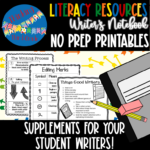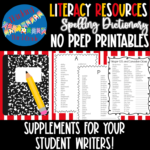Writing. For many teachers, it is a dreaded word and an even more dreaded subject to teach. The thing about writing is that it is so very subjective. What might seem like a masterpiece for one teacher might be a sheer horror to another. There’s no doubt that teaching writing in elementary grades is a challenge!
I struggle with teaching writing, just as many other teachers do. One thing that has made teaching it much more bearable and productive is setting up systems for my student writers.
Writer’s Notebook
A core component of my writing instruction is the writer’s notebook. Students each have their own and I have mine. We use our writer’s notebooks as reference points throughout the year. Students brainstorm ideas and create lists of possible topics that they can come back to time and again. They create journal entries throughout the year on a variety of issues and often times these spark a larger writing piece that they take through the writing process.
Writing Folder
Our writing folders serve two purposes: they house students in progress and completed writing (temporarily, but I’ll get to that in a bit) and they provide a useful writing toolkit. I always use bradded folders and have them set up in the following way:
- The left side of their folder holds all their works-in-progress, as well as abandoned works.
- The bradded section contains their Writer’s Reference and Spelling Dictionary.
- The right side of their folder is where they keep any works that have gone through the entire writing process and are considered, “published”.
- Completed, Published Works Pocket in Folder
- Works in Progress & Abandoned Works
Writer’s Toolkit
Several years ago, when I was leaving a long stretch of teaching just math and science and returning to the self-contained classroom, I knew I needed a plan for teaching writing again. I created my Writer’s Toolkit, which I also refer to as a Writer’s Notebook, though it differs from the Writer’s Notebook I use in my classroom. It could easily be incorporated into an actual composition book or spiral.
Early in the year, before we become completely immersed in our writing workshop, I teach students how to use their Writer’s Toolkit. We go over how to create a list of topics to write about (which I actually do an entire lesson on). I talk to them about making sure their sentences have SWAG (starts with a capital, written neatly, a space between each word, given punctuation at the end). Students use how to use editing marks, once we get to the editing process.
It’s a really amazing experience to see students use their toolkit on their own without being reminded. This will take a couple of months – at least – of practice and modeling, but will see fruition!
- Cover Page for a Writer’s Tool Kit
- Table of Contents in a Writer’s Tool Kit Folder
- Topic Ideas in a Writer’s Took Kit Folder
- Things Good Writers Do in a Writer’s Tool Kit Folder
- Smaller Pages for the Writer’s Notebook
- One page of editing marks in a Writer’s Notebook
Spelling Dictionary
A good spelling dictionary is hands-down the best thing you could ever do for your students writers AND yourself! I created my Spelling Dictionary at the same time as the Writer’s Toolkit and I have given myself a pat on the back for it ever since. Like the Writer’s Toolkit, it takes time and modeling, but will pay off big.
There are few bigger time sucks than having to spell words for students who want to make sure they are spelling everything correctly and doing their best. Of course, we as teachers, want to help every single one of our students and see them succeed. But a constant barrage of children asking you to spell out words for them takes away from time that can be spent conferencing with students and helping them improve their compositions.
A spelling dictionary works like this: students are provided with an alphabetical list of commonly misspelled words. In addition to the words already provided, there is space for students to add words they want to include in their writing. My Spelling Dictionary has all that and lists of major U.S. and Canadian cities, states, provinces, world countries, numbers, and more. Additionally, there is a page for recording the correct spellings of the names of friends and family members.
- Spelling Dictionary in Writer’s Tool Kit Folder
- Spelling Dictionary – World Cities
Cumulative Writing Folder
My school district requires that we submit a minimum of 5-6 pieces of students’ completed writing each year to their cumulative writing folder. This folder travels with them throughout the school (and district, if they change schools) from Pre-K until they leave elementary school after 5th.
In my class, students self-select and reflect on the pieces that they have chosen to include. I aim for working on this at the end of each six weeks, so that we aren’t scrambling at the very end of the year, throwing anything we can find into their cumulative folder.
Building Confident Writers
I hope these ideas help ease the sometimes painful process of teaching writing. The products I mentioned in this post –Writer’s Toolkit and Spelling Dictionary can be found in my Teachers Pay Teachers store! Check them out! I know they will be helpful to you and your students!
- Writer’s Notebook/Tool Kit and Spelling Dictionary
- Writer’s Tool Kit on TpT
- Spelling Dictionary on TpT
Please take a moment to sign up for my email newsletter where I keep you apprised of all my latest blog posts and products! Sign up below!
And third grade teachers, come join our brand new Thinking Third Grade Teachers Facebook Group that was created just for you!
Have a great rest of your Sunday and a wonderful week, everyone! Talk soon!














Leave a Reply